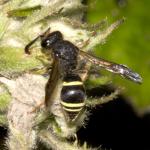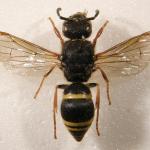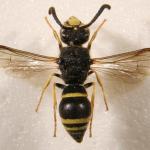Ancistrocerus albotricinctus (Zetterstedt, 1838); Ancistrocerus trimarginatus misident.
Previously known as A. albotricinctus (Zetterstedt, 1838) and sometimes misidentified as A. trimarginatus (Zetterstedt, 1838). A colour form in Ireland and the Scottish Isles has ivory white tergal bands; elsewhere the bands are bright yellow. Identification keys and general biology are given in Julliard (1950), Blüthgen (1961), Spradbery (1973), Richards (1980) and Yeo & Corbet (1995).
Found throughout England, Wales and Scotland (except Orkney and Shetland) and coastal Ireland, but not recorded from the Channel Islands. Mainly a coastal species in England and Wales.
Overseas, occurs in many parts of Europe (Sweden, Finland, Denmark, The Netherlands, Belgium, France, Spain, Germany, Switzerland, Italy, Poland, Austria, Bulgaria), North Africa (Morocco) and Asia (Manchuria and Korea to Kamchatka).
Not listed in Shirt ( 1987) or in Falk (1991). The scarcity of modern records from some areas suggests there may be a decline at inland localities in England and Wales.
Found in a wide variety of habitats: moorland, sandy areas including low land heaths, clay and sandy woodlands, parkland, limestone and sandstone quarries, limestone grassland, urban areas (gardens), coastal cliffs and heaths, marshes, sand dunes and shingle areas.
Probably univoltine; mainly June to August, sometimes during May and September, and rarely in April.
Small Lepidoptera caterpillars, but also some chrysomelid beetle larvae.
According to Blüthgen (1961) this wasp normally builds its clay cells in hollow spaces (crevices in rocks, cracks in bridges, holes in pebbles and slag at a mine, among the bark of pine trees, dead stems such as elder and in reeds). In the alpine region of Switzerland, Julliard (1950) found that the female can burrow into flat bare soil to form its oval cells, made mainly of clay. The openings of the cells are flush with the surface of the ground and cells may be grouped together.
Sea-holly, bramble, hogweed and thistles.
Chrysis ignita (Linnaeus) and probably C. rutiliventris Abeille de Perrin (Morgan, 1984).
1998




